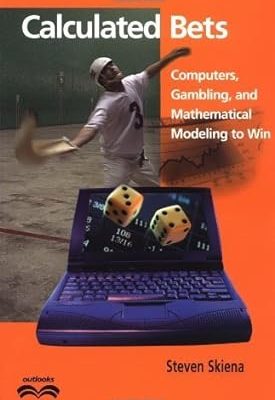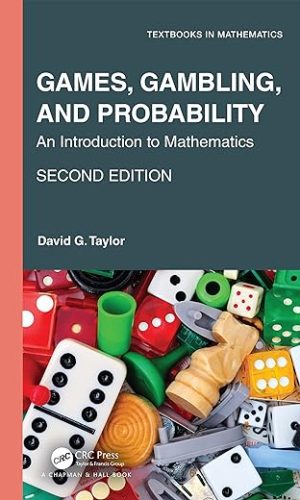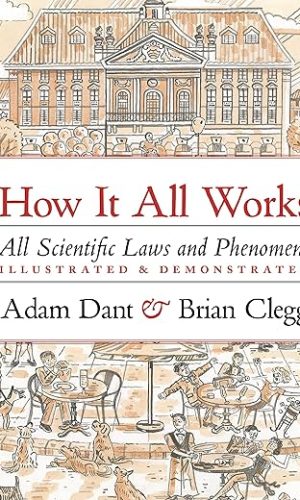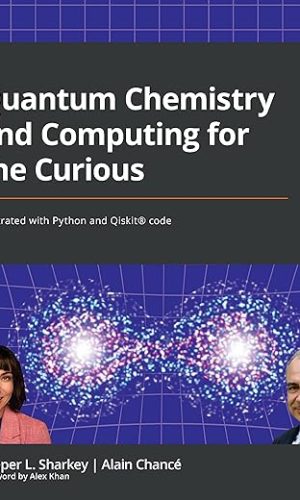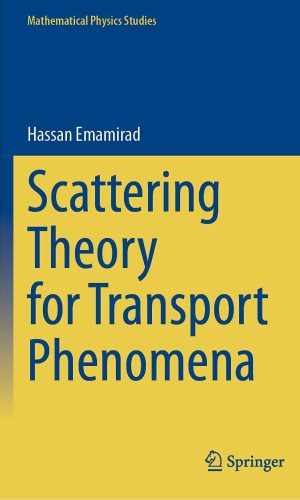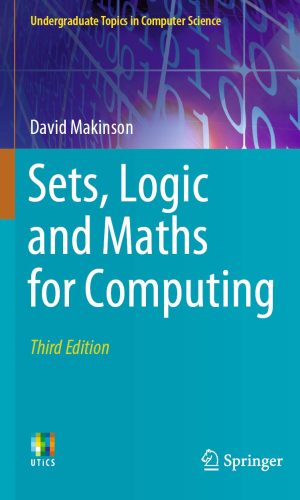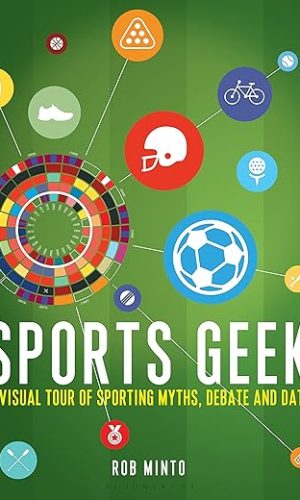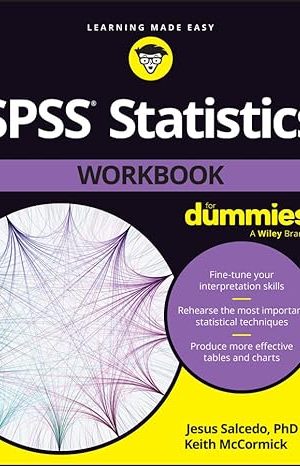Mathematics
-
Calculated Bets: Computers, Gambling, and Mathematical Modeling to Win (Outlooks)
This is a book about a gambling system that works. It tells the story of how the author used computer simulations and mathematical modeling techniques to predict the outcome of jai-alai matches and bet on them successfully – increasing his initial stake by over 500% in one year! His results can work for anyone: at the end of the book he tells the best way to watch jai-alai, and how to bet on it. With humour and enthusiasm, Skiena details a life-long fascination with computer predictions and sporting events. Along the way, he discusses other gambling systems, both successful and unsuccessful, for such games as lotto, roulette, blackjack, and the stock market. Indeed, he shows how his jai-alai system functions just like a miniature stock trading system. Do you want to learn about program trading systems, the future of Internet gambling, and the real reason brokerage houses don’t offer mutual funds that invest at racetracks and frontons? How mathematical models are used in political polling? The difference between correlation and causation? If you are curious about gambling and mathematics, odds are this book is for you!Read more
£22.60 -
Games, Gambling, and Probability: An Introduction to Mathematics (Textbooks in Mathematics)
Many experiments have shown the human brain generally has very serious problems dealing with probability and chance. A greater understanding of probability can help develop the intuition necessary to approach risk with the ability to make more informed (and better) decisions.
The first four chapters offer the standard content for an introductory probability course, albeit presented in a much different way and order. The chapters afterward include some discussion of different games, different “ideas” that relate to the law of large numbers, and many more mathematical topics not typically seen in such a book. The use of games is meant to make the book (and course) feel like fun!
Since many of the early games discussed are casino games, the study of those games, along with an understanding of the material in later chapters, should remind you that gambling is a bad idea; you should think of placing bets in a casino as paying for entertainment. Winning can, obviously, be a fun reward, but should not ever be expected.
Changes for the Second Edition:
- New chapter on Game Theory
- New chapter on Sports Mathematics
- The chapter on Blackjack, which was Chapter 4 in the first edition, appears later in the book.
- Reorganization has been done to improve the flow of topics and learning.
- New sections on Arkham Horror, Uno, and Scrabble have been added.
- Even more exercises were added!
The goal for this textbook is to complement the inquiry-based learning movement. In my mind, concepts and ideas will stick with the reader more when they are motivated in an interesting way. Here, we use questions about various games (not just casino games) to motivate the mathematics, and I would say that the writing emphasizes a “just-in-time” mathematics approach. Topics are presented mathematically as questions about the games themselves are posed.
Table of Contents
Preface
1. Mathematics and Probability
2. Roulette and Craps: Expected Value
3. Counting: Poker Hands
4. More Dice: Counting and Combinations, and Statistics
5. Game Theory: Poker Bluffing and Other Games
6. Probability/Stochastic Matrices: Board Game Movement
7. Sports Mathematics: Probability Meets Athletics
8. Blackjack: Previous Methods Revisited
9. A Mix of Other Games
10. Betting Systems: Can You Beat the System?
11. Potpourri: Assorted Adventures in Probability
Appendices
Tables
Answers and Selected Solutions
BibliographyBiography
Dr. David G. Taylor is a professor of mathematics and an associate dean for academic affairs at Roanoke College in southwest Virginia. He attended Lebanon Valley College for his B.S. in computer science and mathematics and went to the University of Virginia for his Ph.D. While his graduate school focus was on studying infinite dimensional Lie algebras, he started studying the mathematics of various games in order to have a more undergraduate-friendly research agenda. Work done with two Roanoke College students, Heather Cook and Jonathan Marino, appears in this book! Currently he owns over 100 different board games and enjoys using probability in his decision-making while playing most of those games. In his spare time, he enjoys reading, cooking, coding, playing his board games, and spending time with his six-year-old dog Lilly.
Read more
£70.40 -
How it All Works: All scientific laws and phenomena illustrated & demonstrated
In this beautiful and unique combination of art and science, this stunningly detailed book examines how the rules of science govern the the world around us, from the rooms in our houses to the planet, the solar system and the universe itself!
The Universe is inconceivably complex. Its component parts though follow a set of unbreakable laws that have somehow been coded into their very fabric since the beginning of time. These laws play out in different ways at different scales, giving rise to the familiar phenomena of everyday life – as well as the unfamiliar abstract goings-on outside our experience and awareness. Understanding these laws may seem a daunting task, until now.
How it All Works illustrates simply how the most interesting and complex named scientific laws and phenomena affect everyone’s daily lives. Using hyper-detailed scene illustrations from the incredible award-winning artist Adam Dant, we start small, with the illustrated science inside your kitchen, before expanding outwards to encompass your garden, street, city, continent, planet, solar system, galaxy and eventually the whole universe.
With tiny details pulled out from visually stunning and intricate scene, learn how:
- Kirchhoff’s Law affects how you charge your phone,
- Newton’s Law of Cooling helps you make your coffee just the right temperature to drink,
- How the rules of antimatter are used in hospitals for medical imaging,
- How Cassie’s law keeps ducks dry,
- How glaciation shapes the ladscapes around us,
- How thermohaline circulation dictates our weather, and
- How quantum tunnelling influences the nuclear fusion in our sun, and Wien’s Law determines its colour.
This book will astound and inform in equal measure, with each principle drawn into the scene and explained with clarity by leading science writer Brian Clegg.
With a reference section at the back as well as profiles of the key figures who have helped shape our understanding of these key principles, from Lynn Margulis and Richard Feynman to Marie Curie, Michael Faraday,Isaac Newton and Albert Einstein, this beautiful and unique visual examination of the rules of science is an must-have book for anyone who wants to understand the physics, chemistry and biology of the world around us!
Read more
£4.10 -
Lectures on Optimal Transport (UNITEXT Book 130)
This textbook is addressed to PhD or senior undergraduate students in mathematics, with interests in analysis, calculus of variations, probability and optimal transport. It originated from the teaching experience of the first author in the Scuola Normale Superiore, where a course on optimal transport and its applications has been given many times during the last 20 years. The topics and the tools were chosen at a sufficiently general and advanced level so that the student or scholar interested in a more specific theme would gain from the book the necessary background to explore it. After a large and detailed introduction to classical theory, more specific attention is devoted to applications to geometric and functional inequalities and to partial differential equations.
Read more
£40.30 -
Quantum Chemistry and Computing for the Curious: Illustrated with Python and Qiskit® code
Acquire knowledge of quantum chemistry concepts, the postulates of quantum mechanics, and the foundations of quantum computing, and execute illustrations made with Python code, Qiskit, and open-source quantum chemistry packages
Key Features
- Be at the forefront of a quest for increased accuracy in chemistry applications and computing
- Get familiar with some open source quantum chemistry packages to run your own experiments
- Develop awareness of computational chemistry problems by using postulates of quantum mechanics
Book Description
Explore quantum chemical concepts and the postulates of quantum mechanics in a modern fashion, with the intent to see how chemistry and computing intertwine. Along the way you’ll relate these concepts to quantum information theory and computation. We build a framework of computational tools that lead you through traditional computational methods and straight to the forefront of exciting opportunities. These opportunities will rely on achieving next-generation accuracy by going further than the standard approximations such as beyond Born-Oppenheimer calculations.
Discover how leveraging quantum chemistry and computing is a key enabler for overcoming major challenges in the broader chemical industry. The skills that you will learn can be utilized to solve new-age business needs that specifically hinge on quantum chemistry
What you will learn
- Understand mathematical properties of the building blocks of matter
- Run through the principles of quantum mechanics with illustrations
- Design quantum gate circuit computations
- Program in open-source chemistry software packages such as Qiskit®
- Execute state-of-the-art-chemistry calculations and simulations
- Run companion Jupyter notebooks on the cloud with just a web browser
- Explain standard approximations in chemical simulations
Who this book is for
Professionals interested in chemistry and computer science at the early stages of learning, or interested in a career of quantum computational chemistry and quantum computing, including advanced high school and college students. Helpful to have high school level chemistry, mathematics (algebra), and programming. An introductory level of understanding Python is sufficient to read the code presented to illustrate quantum chemistry and computing
Table of Contents
- Introduction
- Postulates of quantum mechanics
- Quantum circuit model of computation
- Molecular Hamiltonians
- Variational Quantum Eigensolver (VQE) algorithm
- Beyond Born-Oppenheimer
- Conclusion
- References
- Glossary
Read more
£23.70 -
Scattering Theory for Transport Phenomena (Mathematical Physics Studies)
The scattering theory for transport phenomena was initiated by P. Lax and R. Phillips in 1967. Since then, great progress has been made in the field and the work has been ongoing for more than half a century. This book shows part of that progress.
The book is divided into 7 chapters, the first of which deals with preliminaries of the theory of semigroups and C*-algebra, different types of semigroups, Schatten–von Neuman classes of operators, and facts about ultraweak operator topology, with examples using wavelet theory.
Chapter 2 goes into abstract scattering theory in a general Banach space. The wave and scattering operators and their basic properties are defined. Some abstract methods such as smooth perturbation and the limiting absorption principle are also presented. Chapter 3 is devoted to the transport or linearized Boltzmann equation, and in Chapter 4 the Lax and Phillips formalism is introduced in scattering theory for the transport equation.
In their seminal book, Lax and Phillips introduced the incoming and outgoing subspaces, which verify their representation theorem for a dissipative hyperbolic system initially and also matches for the transport problem. By means of these subspaces, the Lax and Phillips semigroup is defined and it is proved that this semigroup is eventually compact, hence hyperbolic.
Balanced equations give rise to two transport equations, one of which can satisfy an advection equation and one of which will be nonautonomous. For generating, the Howland semigroup and Howland’s formalism must be used, as shown in Chapter 5.
Chapter 6 is the highlight of the book, in which it is explained how the scattering operator for the transport problem by using the albedo operator can lead to recovery of the functionality of computerized tomography in medical science. The final chapter introduces the Wigner function, which connects the Schrödinger equation to statistical physics and the Husimi distribution function. Here, the relationship between the Wigner function and the quantum dynamical semigroup (QDS) can be seen.Read more
£9.70 -
Sets, Logic and Maths for Computing (Undergraduate Topics in Computer Science)
This easy-to-understand textbook introduces the mathematical language and problem-solving tools essential to anyone wishing to enter the world of computer and information sciences. Specifically designed for the student who is intimidated by mathematics, the book offers a concise treatment in an engaging style.
The thoroughly revised third edition features a new chapter on relevance-sensitivity in logical reasoning and many additional explanations on points that students find puzzling, including the rationale for various shorthand ways of speaking and ‘abuses of language’ that are convenient but can give rise to misunderstandings. Solutions are now also provided for all exercises.
Topics and features: presents an intuitive approach, emphasizing how finite mathematics supplies a valuable language for thinking about computation; discusses sets and the mathematical objects built with them, such as relations and functions, as well as recursion and induction; introduces core topics of mathematics, including combinatorics and finite probability, along with the structures known as trees; examines propositional and quantificational logic, how to build complex proofs from simple ones, and how to ensure relevance in logic; addresses questions that students find puzzling but may have difficulty articulating, through entertaining conversations between Alice and the Mad Hatter; provides an extensive set of solved exercises throughout the text.
This clearly-written textbook offers invaluable guidance to students beginning an undergraduate degree in computer science. The coverage is also suitable for courses on formal methods offered to those studying mathematics, philosophy, linguistics, economics, and political science. Assuming only minimal mathematical background, it is ideal for both the classroom and independent study.
Read more
£28.00 -
Sports Geek: A visual tour of sporting myths, debate and data
Sport revolves around two things: narrative and numbers. You need the narrative, otherwise why would anyone care about sport? Rivalries, emotions, and sporting legends all require it. But sport also needs numbers. Without them, we have no idea who has won. We need numbers to tell which team is top of the table, or who is the world champion.Sports Geek is a visual and numerical tour through sporting debates and ideas. Teams in all sports use data to create extraordinary analysis of how their players perform, to assess tactics and to get an edge over arch rivals; but fans are rarely presented with challenging and informative data that would help them to further understand sport.
You’ll never see sport the same way again.
Read more
£10.00 -
SPSS Statistics Workbook For Dummies
Practice making sense of data with IBM’s SPSS Statistics software
SPSS Statistics Workbook For Dummies gives you the practice you need to navigate the leading statistical software suite. Data management and analysis, advanced analytics, business intelligence—SPSS is a powerhouse of a research platform, and this book helps you master the fundamentals and analyze data more effectively. You’ll work through practice problems that help you understand the calculations you need to perform, complete predictive analyses, and produce informative graphs. This workbook gives you hands-on exercises to hone your statistical analysis skills with SPSS Statistics 28. Plus, explanations and insider tips help you navigate the software with ease. Practical and easy-to-understand, in classic Dummies style.
- Practice organizing, analyzing, and graphing data
- Learn to write, edit, and format SPSS syntax
- Explore the upgrades and features new to SPSS 28
- Try your hand at advanced data analysis procedures
For academics using SPSS for research, business analysts and market researchers looking to extract valuable insights from data, and anyone with a hankering for more stats practice.
Read more
£16.20

